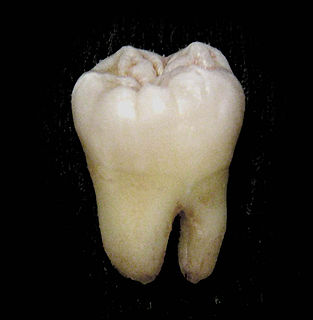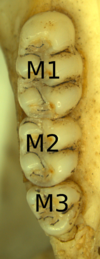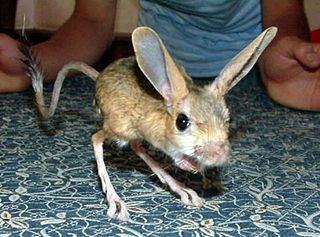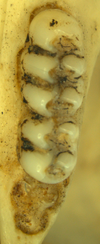
Pouched rats are a group of African rodents in the subfamily Cricetomyinae. They are members of the family Nesomyidae, which contains other African muroids such as climbing mice, Malagasy mice, and the white-tailed rat. All nesomyids are in the superfamily Muroidea, a large and complex clade containing 1/4 of all mammal species. Sometimes the pouched rats are placed in the family Muridae along with all other members of the superfamily Muroidea.

Papagomys is a genus of very large rats in the tribe Rattini of the subfamily Murinae. It contains two species, which are known only from the Indonesian island of Flores:

The suborder Myomorpha contains 1,137 species of mouse-like rodents, nearly a quarter of all mammal species. Included are mice, rats, gerbils, hamsters, lemmings, and voles. They are grouped according to the structure of their jaws and molar teeth. They are characterized by their myomorphous zygomasseteric system, which means that both their medial and lateral masseter muscles are displaced forward, making them adept at gnawing. As in the hystricognathous rodents, the medial masseter muscle goes through the eye socket, a feature unique among mammals. Myomorphs are found worldwide in almost all land habitats. They are usually nocturnal seed-eaters.
The earless water rat is a New Guinea rodent, part of the Hydromys group of the subfamily of Old World rats and mice (Murinae). It is the only species of the genus Crossomys. This species is probably most closely related to Baiyankamys. It is still unclear to which species this group is related. It is one of the most aquatically adapted rodents of the world.

Leptomys is a genus of rodent from New Guinea. It is considered part of the New Guinea Old Endemics, meaning it was part of the first wave of murine rodents to colonize the island.

Ernst Mayr's water rat is a species of rodent in the family Muridae, named for evolutionary biologist Ernst Mayr. It is found in the Foja Mountains of Papua Province, Indonesia, and in the mountains of northeastern Papua New Guinea.
The one-toothed shew mouse is a species of rodent in the family Muridae. It is found in West Papua, Indonesia and Papua New Guinea, at elevations from 1200 to 3000 m. It is most closely related to Pseudohydromys germani.
Musser's shrew mouse is a species of rodent in the family Muridae. It is found only in Papua New Guinea. Its natural habitat is subtropical or tropical moist montane forests.
The eastern shew mouse is a species of rodent in the family Muridae. It is found only in Papua New Guinea.
Pseudohydromys is a genus of rodent in the family Muridae endemic to New Guinea. It contains the following species:
German's one-toothed moss mouse is a species of rodent in the family Muridae which occurs in the mountains of southeastern New Guinea. It has only one molar and only one incisor in each jaw quadrant for a total of eight teeth, less than any other rodents except for its close relative, the one-toothed moss-mouse and the recently described Paucidentomys, which lacks molars entirely. It is known from only one specimen, an adult male which was caught at an altitude of 1300 m in the village of Munimun, Milne Bay Province, southeastern Papua New Guinea in August 1992. P. germani was first described in 2005 by biologist Kristofer Helgen and named after Pavel German, who caught the specimen. It was first described in the genus Mayermys, but this genus, which only included the two one-molared species, has since been synonymised under Pseudohydromys because of the close morphological resemblances among Mayermys and the other species now placed in Pseudohydromys. As a member of the Xeromys division within the subfamily Murinae, P. germani is related to the false water rat of Australia and southern New Guinea and to the three species of Leptomys, another New Guinean genus, and more distantly to other New Guinean and Australian rodents, including the water rat.

In rodent anatomy, the zygomatic plate is a bony plate derived from the flattened front part of the zygomatic arch (cheekbone). At the back, it connects to the front (maxillary) root of the zygomatic arch, and at the top it is connected to the rest of the skull via the antorbital bridge. It is part of the maxillary bone, or upper jaw, which also contains the upper cheekteeth. Primitively, rodents have a nearly horizontal zygomatic plate. In association with specializations in zygomasseteric system, several distinct morphologies have developed across the order.
Guy Graham Musser is an American zoologist. His main research is in the field of the rodent subfamily Murinae, in which he has described many new species.
The southern small-toothed moss mouse is a species of rodent in the family Muridae found on the slopes of Mount Bosavi, Papua New Guinea.

Baiyankamys is a genus of amphibious murid rodents. It was originally described, along with the species Baiyankamys shawmayeri by Hinton in 1943 after he found the remains of a single individual in south east of the Bismarck Mountain Range, north east New Guinea. Tate, in 1951 and, Laurie and Hill in 1954, confirmed the existence of both the species and genus.
Mirza's eastern moss rat is a species of rodent endemic to New Guinea.
Mirza's western moss rat is a species of rodent endemic to Papua New Guinea.
Laurie’s moss mouse is a species of mouse belonging to the family Muridae that is endemic to Papua New Guinea. It was first described in 2009.
Woolley's moss mouse,, is a species of mouse endemic to Papua New Guinea. It was first described in 2009.




















